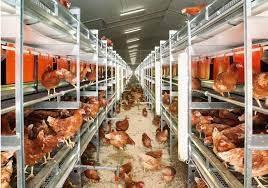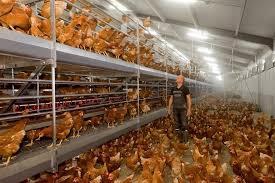Editorial
 During a recent regional meeting, a newly minted assistant professor presented data relating to previous doctoral research conducted at a leading West Coast university. This study was intended to investigate the behavior of pullets transferred to aviaries with respect to their ability and inclination to ascend the three tiers of a module. Pullets were reared in either an aviary structure or in a pen with a raised perch or on litter. The trial confirmed the intuitive reality that pullets reared in an aviary showed greater capability of ascending the tiers of the laying aviary compared too floor-reared pullets. It is axiomatic, but not always followed, that pullets should be reared in an aviary compatible with the system to which they will be transferred.
During a recent regional meeting, a newly minted assistant professor presented data relating to previous doctoral research conducted at a leading West Coast university. This study was intended to investigate the behavior of pullets transferred to aviaries with respect to their ability and inclination to ascend the three tiers of a module. Pullets were reared in either an aviary structure or in a pen with a raised perch or on litter. The trial confirmed the intuitive reality that pullets reared in an aviary showed greater capability of ascending the tiers of the laying aviary compared too floor-reared pullets. It is axiomatic, but not always followed, that pullets should be reared in an aviary compatible with the system to which they will be transferred.
What represented a concern is the fact that only a limited number of hens were the subject of the trial coupled with the extremely limited length of the experimental aviary installation. The trial involved direct transfer from either of the rearing systems to the short lengths of laying aviary modules. This aspect of the experimental design ignored the reality that under commercial practice, pullets are confined for a “training period” of approximately three weeks to acclimate to aviary modules. This may have invalidated the obvious conclusion from the trial that deviated from industry practice.
 It is questioned whether university trials conducted on a small scale are capable of reflecting flock size or behavior under commercial conditions. Extrapolation from limited scale trials frequently of short duration, and often with an injection of subjective sentiment, forms the basis of recommendations regarding flock welfare. These include standards for area requirements, perches, feeder-space and the allowance and position of drinker nipples. Standards adopted and enforced by animal welfare certifying agencies are strongly influenced by the research conducted in both E.U. and the U.S. institutions. Advisory panels in the U.S. frequently comprise the same research scientists who are extending their research, some of which may be of questionable validity, into recommendations that may represent millions of dollars in incremental capital expenditure.
It is questioned whether university trials conducted on a small scale are capable of reflecting flock size or behavior under commercial conditions. Extrapolation from limited scale trials frequently of short duration, and often with an injection of subjective sentiment, forms the basis of recommendations regarding flock welfare. These include standards for area requirements, perches, feeder-space and the allowance and position of drinker nipples. Standards adopted and enforced by animal welfare certifying agencies are strongly influenced by the research conducted in both E.U. and the U.S. institutions. Advisory panels in the U.S. frequently comprise the same research scientists who are extending their research, some of which may be of questionable validity, into recommendations that may represent millions of dollars in incremental capital expenditure.
The performance of small numbers of chickens under experimental conditions does not necessarily conform to the behavior of commercial flocks. Have we been misled by conclusions from inappropriate experiments? Are recommendations really valid in the context of commercial experience? Are subjective safety margins included?
 It is noted that the scientific panels generating welfare standards are composed of academics with minimal contribution from suitably qualified poultry health professionals involved in industry. There is a paucity of published work on the economic impact of standards with respect to capital cost of housing and installations. Initial costs conforming to standards for flock density and required enrichments impose fixed costs of production, including interest, fixed maintenance and depreciation. The question arises as to how to design experiments that will provide realistic results that actually contribute to enhanced welfare and productivity.
It is noted that the scientific panels generating welfare standards are composed of academics with minimal contribution from suitably qualified poultry health professionals involved in industry. There is a paucity of published work on the economic impact of standards with respect to capital cost of housing and installations. Initial costs conforming to standards for flock density and required enrichments impose fixed costs of production, including interest, fixed maintenance and depreciation. The question arises as to how to design experiments that will provide realistic results that actually contribute to enhanced welfare and productivity.
Flock performance is almost entirely neglected as a measure of welfare, although it is intuitively accepted that flocks subjected to suboptimal housing and management demonstrate higher mortality and lower egg production than flocks held under conditions conducive to achieving genotype. It is acknowledged that small-scale experiments that are relatively inexpensive and easy to perform should form the basis of evaluating hypotheses relating to welfare. It is, however, necessary to validate preliminary results under commercial conditions, especially when recommendations and standards impose high fixed costs on producers. Frequently in a competitive environment cost cannot be passed on to consumers reducing the return on investment in a muli-million dollar in-line aviary complex. It is easy for academics to develop inappropriate or invalid standards that effectively represent spending someone else’s money. The situation is compounded by the fact that many of the same researchers serve in common on advisory boards for industry associations, welfare organizations and panels convened by major customer concerns. This creates a giant echo chamber with inadequate impartial and disinterested input.
The solution lies in greater cooperation among research scientists, equipment manufacturers and producers to establish realistic standards of housing and management that support quantifiable welfare, flock performance and financial return